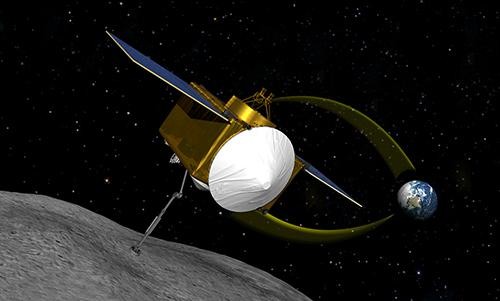The team behind an asteroid sample space probe is preparing for what they hope will be the initiation of a decade of research for the UA.
Their final 1,000-plus page report on the project is due Jan. 28.
OSIRIS-REx — or Origins, Spectral Interpretation, Resource Identification, Security, Regolith Explorer — is a space probe that would be slated to collect a minimum of two ounces of pure asteroid to study at the UA, a year into the project and backed by $3.3 million in NASA funding.
The plan for the probe will be tested in a 10-hour site visit held in Denver on April 14, along with its two competitors: a Venus mission and a moon mission, presented by the University of Colorado at Boulder and Washington University in St. Louis.
NASA staff will evaluate a series of presentations ranging from logistics to budgets and several previously constructed models of various probe parts.
“”The focus is to identify those risks and retire those,”” said Dante Lauretta, associate professor of cosmochemistry and planet formation and deputy chief of the OSIRIS-REx mission.
Heather Enos, OSIRIS-Rex project planning and control officer, is in charge of the budget for the up to $650 million project.
“”People are very excited,”” Enos said of the project team. “”The good thing about it is that over the year we have become a very strong team. It’s a great opportunity for NASA and the University of Arizona as well as the American public at large, and I’m really proud of the product.””
This is one of several missions Enos has been a part of, including the Phoenix Mars Lander mission, but she feels this project is special.
“”The glory of OSIRIS-Rex is its impact, and I think that’s really the next cutting edge of engineering and science technology,”” she said, “”and, because it is such a long duration and such an amazing scientific endeavor, I think for the University of Arizona and the public a variety of opportunity in lots of different areas.””
Several undergraduate and graduate students from both inside lunar and planetary sciences as well as humanities and business would all be needed to complete the project.
“”It’s really the tentacles to weave through the community to really get people involved,”” she said.
Enos said the UA administration is quite supportive of their team and their initiative to garner this type of grant.
The core team of 10 student and faculty members created the more than 1,000 page concept report as well as some other features. A student on the project in fact created a Facebook page for the probe that now boasts more than 1,600 friends and posts the latest on the project.
The probe would depart in September 2016 from Cape Canaveral, Fla., and land back on Earth, in the Utah desert, in 2023, bringing back samples from the asteroid, which is older than Earth, to test for previous life and lay the groundwork for manned NASA missions in the future.
“”It’s bigger than Phoenix (Mars Lander),”” Lauretta said. “”It means jobs, it means money, it means prestige, it means awesome science for well over a decade.””
Enos had a similar feeling about the project.
“”Win or lose,”” she said, “”I always say: One, you can’t win if you don’t play; and two, if you never ask the question, the answer is definitely no.””









